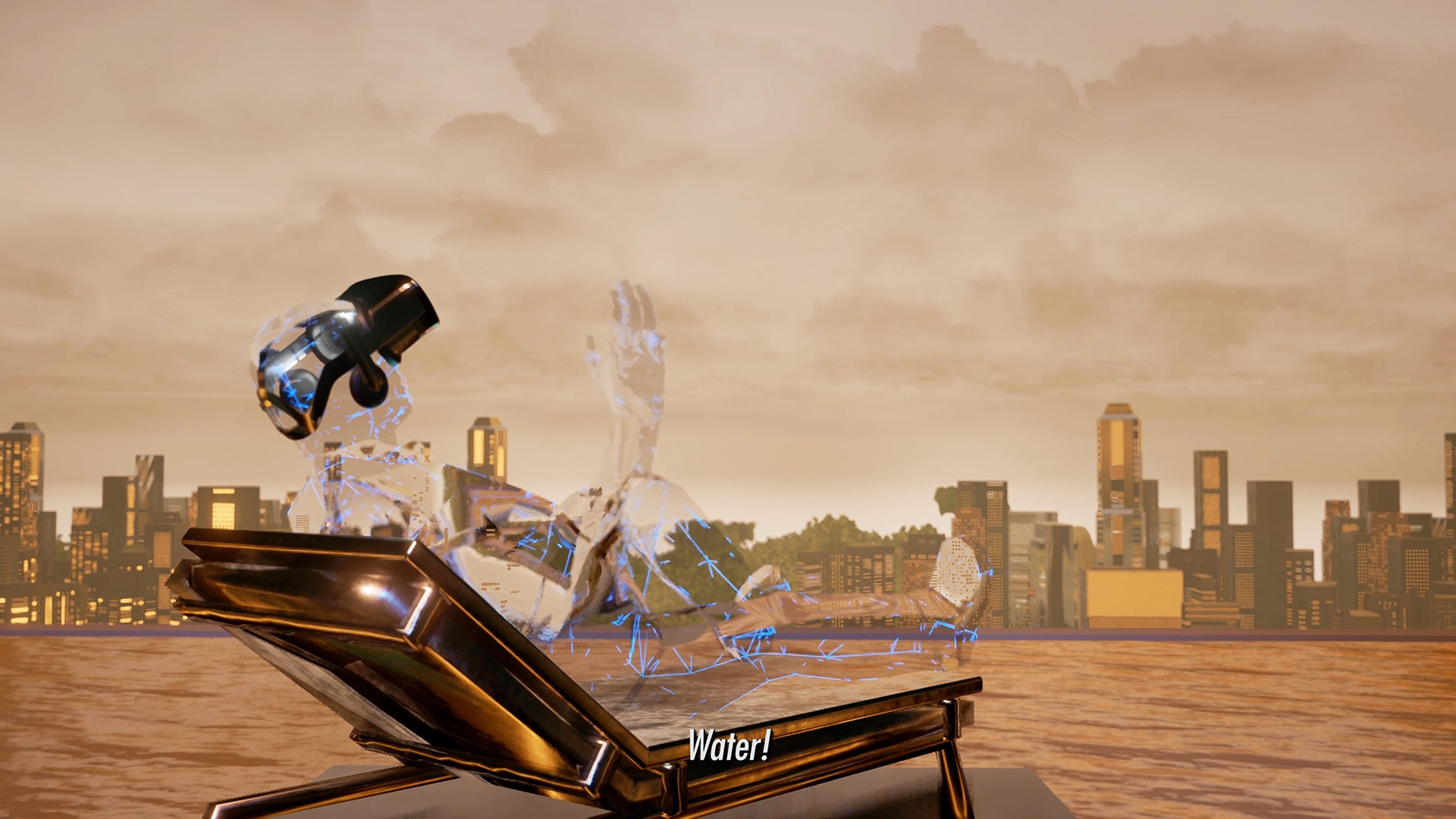You Never Render The Same River Twice
Lucia Kan-Sperling
On Lawrence Lek’s game engine worlds
On my laptop, crisp, computer-generated images. Evenly distributed snow falls diagonally across the screen as the camera shifts slowly to the right; in the background, a four-tiered, feudal-era Chinese building and white-capped mountains. The camera flies between two high cliffs, along the path of a winding river, before diving to water level, whipping around a curve and just missing a smattering of glistening rocks. A view through tangled jungle vegetation covered in white frost; the camera glides in an impossibly smooth arc, and thick, white fog—or is it smoke?—curls in the sky behind sparse palm trees. Meanwhile, a high-pitched synthetic voice harmonizes with itself against ambient synths and a distorted, bamboo flute-style wind instrument. Lyrics appear in glowing font in the middle of the screen, turning from blue to white, karaoke-style. I read: I AM LOOKING FOR MY FRIENDS / HAVE YOU SEEN THEM / MAYBE THEY WILL PASS HERE AGAIN / WRITING NEW SONGS FOR THE SHOW / WATCHING CLOUDS GLOW / CATCHING GLIMPSES OVER RAINBOWS.
My body feels light, my brain feels heavy, something between hypnosis and motion sickness. I idle. I breathe in. I breathe out.
I don’t play video games, but I’ve always been attracted to the spaces inside them. Most video games include at least a rudimentary imagined setting or expository narrative to bolster gameplay, but the best ones provide their player with a fully coherent world. They create a complex system of intricate character design, comprehensive frame stories, and detailed visual landscapes, combined with the imposition of harsh agentive parameters and comparatively primitive objectives: fulfill a mission, shoot your enemies, win. The last video game I seriously played, when I was about eight years old, was Pixie Hollow, a Disney MMORPG (Massively Multiplayer Online Role-Playing Game) in which you could acquire objects and money by playing mini-games located in 17 different “meadows.” The game was not first- or third-person, and there was no 3D animation. ‘Your’ fairy hovered amidst dozens of others in front of a 2D digital drawing of a sunflower field or a giant pumpkin—more akin to a painted stage set than an inhabitable space. The meadows, though, were beautiful. In my favorite, Springtime Orchard, glossy blades of grass loomed in the foreground; behind them, soft light spilled out of a fairy house in the trunk of a bright pink cherry tree; even further back, and blurry, a lush green field and hazy turquoise horizon. The depth of field transfixed me. I would click around the screen for hours, imagining myself somehow jumping inside and unveiling a hidden expanse behind the tantalizing backdrop.
The earliest known use of the term “worldbuilding” is in the 1820s. According to Wikipedia, astronomer Arthur Eddington used the word in 1920 to describe the imagination of physical laws in hypothetical worlds. Fantasy authors like J. R. R. Tolkien were the first to explicitly refer to the creation of a “Secondary World” as a writing tool (Tolkien, 1947). Worldbuilding gained traction in the film industry in the 2000s; production designer Alex McDowell describes it as a storytelling method that starts not with a linear plot, but with the creation of multiple characters or points of view in relation to a broader environment. This strategy creates a “spherical narrative space” from which “a multitude of potential narratives could emerge.”
McDowell and his colleagues Laura Cechanowicz and Brian Cantrell denote the practice of worldbuilding as “post-cinematic”; and, indeed, the most popular examples of worldbuilding in film today are not single works of cinema, but massive media franchises like the Marvel Cinematic Universe. More importantly, cinema as an entertainment medium has been dramatically eclipsed in popularity by video games, which became the highest-grossing entertainment industry around 2013 and now makes a revenue five times as high as the film industry, according to a 2022 FTC document.
To realize their worlds, contemporary video games rely on computer animation. Motion graphics were pioneered by John Whitney in the 1950s, around the same time as the creation of the first video games. In the ’70s, while the first rudimentary arcade games like Pong (whose gameplay consisted of a dot and two lines) gained popularity, feature films were already starting to integrate 3D CGI. However, through the ’90s and onward, as video games became ever more popular and computers got faster, increasingly photorealistic 3D computer animation became accessible to the average person on their own home game consoles.
In high school, the first (and only) time I watched someone play Grand Theft Auto, I was entranced by its sheer detail. Far from the flat, unchanging meadows of Pixie Hollow, we were traversing the photorealistic streets of San Andreas head-on. Our gaze swiveled left and right as we drove, revealing teeming “pedestrians” beyond the car windows—regular people with their own dialogue and daily routines, details you could so easily have missed. Once again, I found myself seized with the desire to abandon the mission, veer the car into an alley and enter a store in a random strip mall, see how deep inside we could go. (I’ve since learned that this is, in fact, possible, via GTA V’s Story Mode.)
The level of interactivity of the player with its visual environment in contemporary video games means that they rely heavily on real-time 3D graphics rendering, whereby the 2D images on-screen are generated from 3D models based on live user input, prioritizing the speed of reactivity in simulating motion. Whereas 30 years ago, innovations in CGI reached movies first, today, the film industry has begun to adopt technology originally developed for video games. Game engines—software frameworks that, among other things, facilitate real-time rendering and manage a range of animation features like physics, lighting, and sometimes camera placement—are now often used as a pseudo-storyboarding method for live-action films, as well as for on-set interaction with CGI.
3D animation in game engines privileges not the linear creation of a story, but the live interplay of a user(s) and objects in an imaginary environment. Used to envision variable possible physical relations between invented objects in a virtual space, it is a well-suited tool for worldbuilding practices—“spherical” approaches to narrative. And while artists have started to explore the creative possibilities of the medium beyond game design1, these explorations still tend to retain a certain aesthetic: one that centers the camera/viewer/player as the primary actor.
1 Other contemporary artists that use game engines to make films or multimedia work include Jacky Connolly, Lu Yang, Cao Fei, Ian Cheng, and Miao Ying.
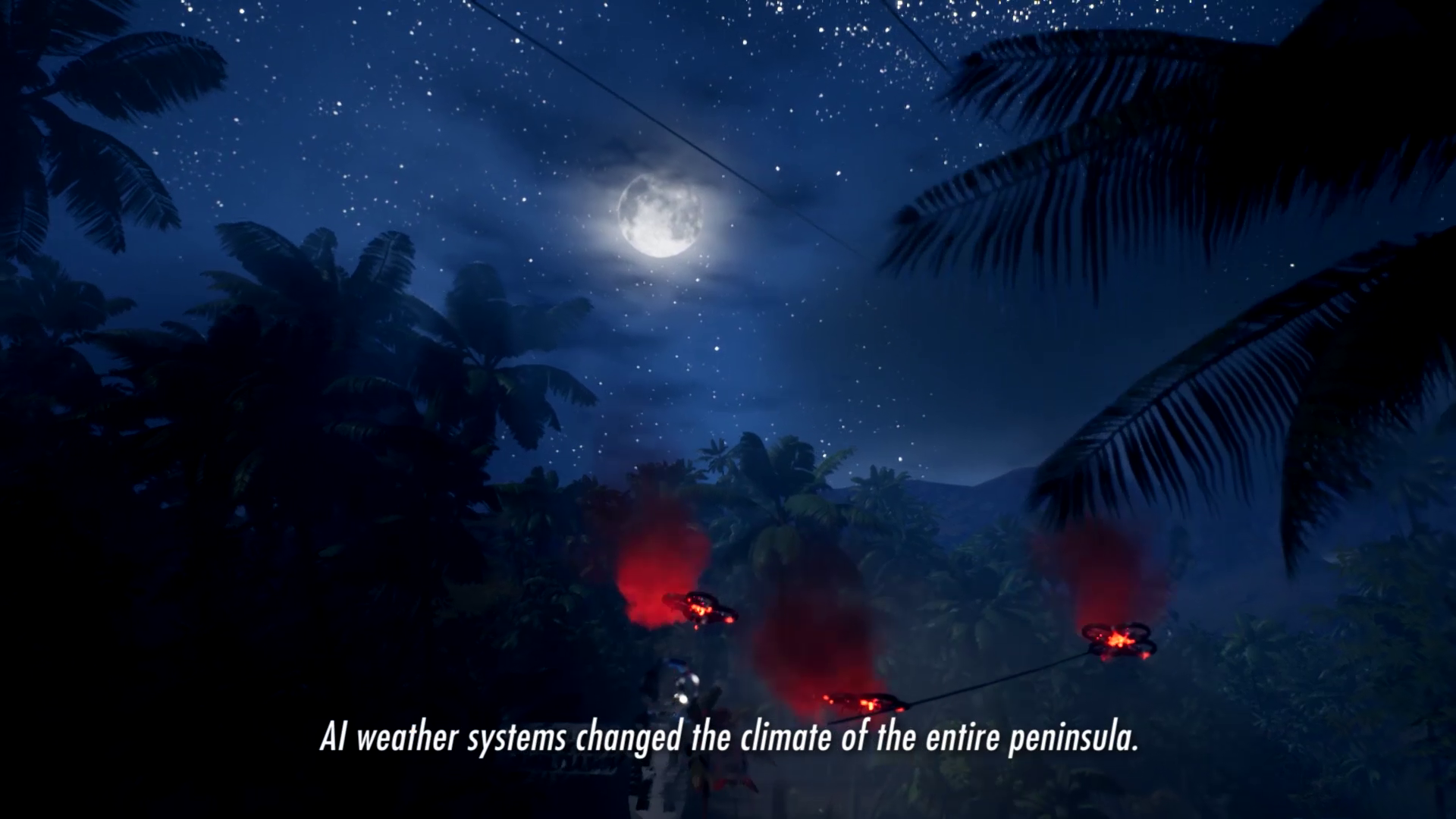
The snowy mountains and drifting camera and karaoke lyrics are from “Track 8: Superstar Lyric Video,” a scene from Malaysian-Chinese multimedia artist Lawrence Lek’s 2019 CGI film AIDOL (the clip is just called “Superstar” on Youtube). AIDOL and its predecessor Geomancer (2017) were both made using the game engine Unreal. They take place in 2065, in and around fantastical postindustrial cities based on Singapore and Malaysia, respectively, and follow a flying superintelligent military surveillance AI named Geomancer (“Geo”) and a human pop star named Diva. Both films feature extensive long takes that float along fantastical landscapes, follow Geo through the futuristic buildings of “Sim-Singapore,” or show a sniper’s view inside the fictional video game “Call of Beauty.” These images are accompanied by voiceovers explaining convoluted, somewhat absurd plots and backstories: the so-called “Bio-Supremacist” human government has banned AIs from making art, upholding “creative genius” as the last vestige of human exceptionalism. An upcoming Call of Beauty tournament at the 2065 E-Sports Olympics will be a test of AI-human relations, which have been strained since an AI beat a human in a game of Go for the first time in 2046 (a confusing plot point, since this already happened in our world in 2016). While Geo dreams of possessing human creativity and an individual artistic identity, a group of rogue AI separatists wish to reclaim their machinic existence.
Lek’s attention to the structure of space in Geomancer and AIDOL reveals his training as an architect. A green-tinged cityscape, seen from under the surface of a body of rippling, viscous water; an underground cave, lit only by the red glow of tiny drones, that opens into a massive room constructed out of QR codes; a flickering bonfire burning in the middle of a snowy, desolate mountainscape, which the camera zooms out of to reveal it is only an image playing on the screen in Diva’s recording studio decorated with glittering red wallpaper and flashing mirrors. The viewer is led through Lek’s world through a camera in constant motion: sometimes the mechanic swivel of a Call of Beauty player’s subjective POV; sometimes a smoothly floating frame that follows Diva or Geo from behind in a third-person tracking shot, as though attached by an invisible string. A wide, almost birds-eye view will suddenly plummet to ground level in a perfect, dangerous swoop.
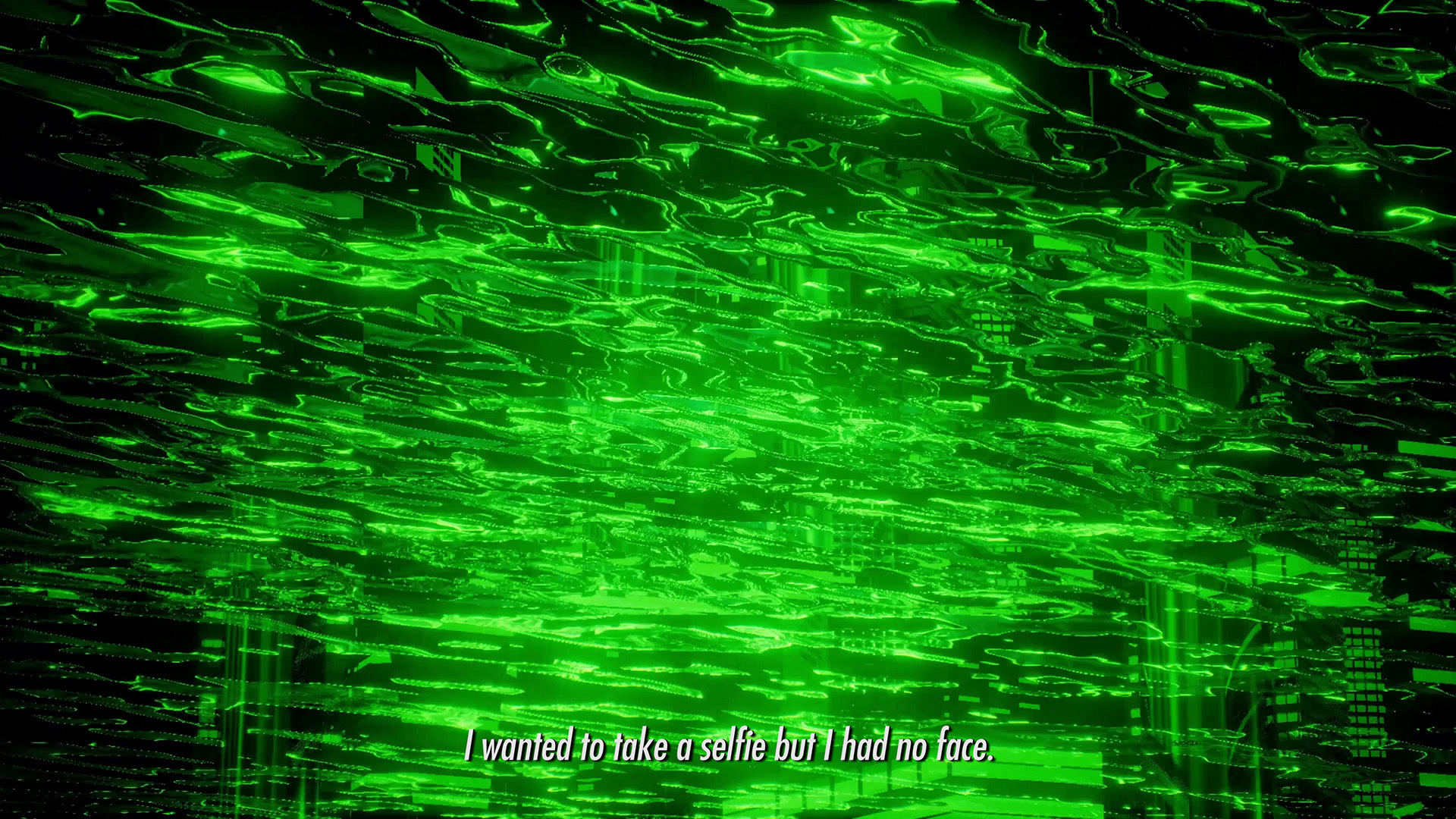
These camera angles are clearly borrowed from the language of video games. As media theorist Alexander Galloway writes in Gaming: Essays on Algorithmic Culture (2006), although cinema invented the first-person subjective camera angle, the video game—specifically, first-person shooter games—made it ubiquitous. First-person shooters, as well as third-person shooters, fuse the camera with the game character’s body (or, in the latter case, with a point directly behind the body) to maximize the player’s feeling of agency and subjectivity with regard to the game’s “computerized,” “fully rendered, actionable space.”
Geomancer and AIDOL, however, are not video games, but films. They are not playable, only watchable. Lek’s subjective angle, then, provides the viewer with an aesthetic simulation of agency in his world—like one would have in a video game—without actually granting it. As a result, his films emphasize the comparative lack of interactivity allowed by their medium. The camera’s constantly switching perspectives—from first-person to third-person subjective shot, to the inside of a fictional game—exacerbate what Galloway points out about the subjective camera in video games: it is not the gaze of any specific character, but the computer’s “gaze of [its] own.”
Indeed, the camera appears to rove through Lek’s masterfully rendered, usually empty CGI spaces with no discernible focus, as though on autopilot: in AIDOL, comparatively little screen time is given to the apparent protagonist, Diva, who exists only as a fuzzy, faceless hooded figure. The overload of background information via voiceover seems disconnected from what the camera actually shows. The same shots of landscapes are repeated at certain points throughout, giving the effect of endless scroll, or of staring at a really intricate screensaver.
I found Galloway’s Gaming while on a mission to define this paradoxical visual language I was fascinated by, but hadn’t been able to name. The book argues that video games are “fundamentally cybernetic software systems involving both organic and nonorganic actors,” algorithmic machines that depend on codified “grammars of action” performed by both the machine and the player. Galloway delineates these actions along two axes: machine acts vs. operator acts, and diegetic vs. nondiegetic acts.
First, Galloway defines “diegetic machine acts,” actions performed by the machine that still have a function within the narrative of gameplay. His primary example is the state of idleness that occurs in many games when the player steps away, but doesn’t press pause:
a moment of equilibrium…a state of rest. The game is slowly walking in place, shifting from side to side and back again to the center. It is running, playing itself, perhaps. The game is in an ambient state, an ambience act.…No significant stimulus from the game environment will disturb the player character.…While the machine pauses in a pause act and the operator is free to take a break, it is the operator who is paused in an ambience act, leaving the machine to hover in a state of pure process. (Galloway 10)
This passage perfectly describes my experience watching Geomancer and AIDOL: the feeling of being on indefinite pause. In addition to the films’ strangely non-identifiable subjective shots, many of the films’ scenes seem to simulate ambience acts: for example, one of the opening shots of Geomancer, a very long, slowly shifting view of a huge Go board underneath an endless surface of clear, undulating water reflecting the deep orange sunset on the horizon. As Galloway writes of the ambience act, these periods of idleness seemed, for me, to take away any subjective identification with the film beyond the aesthetic. A game without a player, a machine without an operator. If Lek was envisioning a possible future world here, I was not a part of it.
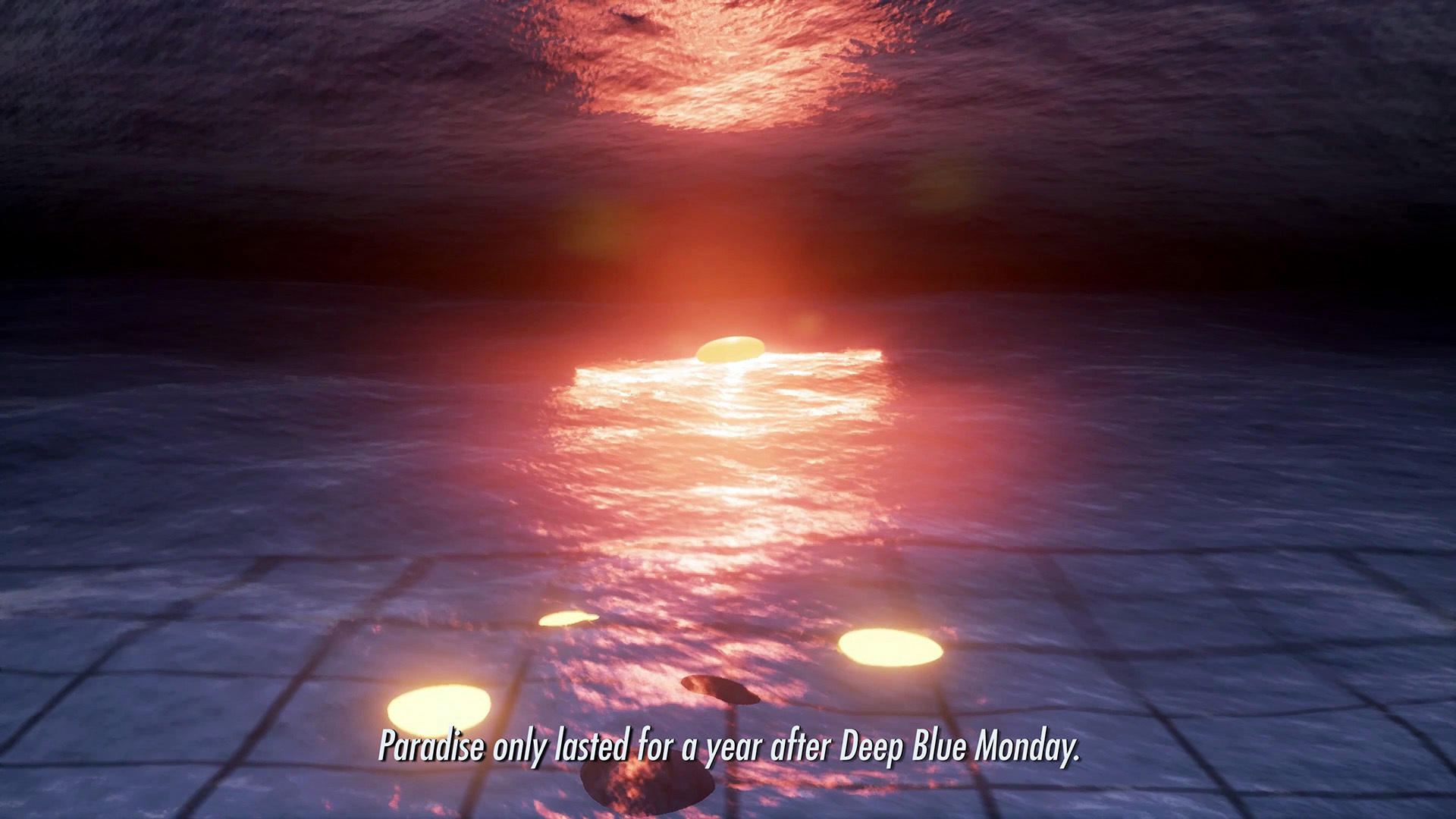
Laura Cechanowicz et al. point out that worldbuilding, primarily a design principle, is well-suited for envisioning the role of technology in possible futures. Lek has explicitly used the term to describe his own artistic practice—he considers “virtual worlds” his cinematic medium—and his website states that he is in the process of creating a “Sinofuturist cinematic universe.” His 2016 video essay Sinofuturism provides the conceptual basis for this universe and is the first work in what he has dubbed the “Sinofuturism trilogy,” preceding Geomancer and AIDOL.
The video, which Lek describes as “a conspiracy theory and manifesto,” features a female, computer-generated voice narrating over a montage of found internet footage, including a professional League of Legends match between China and South Korea, many documentaries about China from American and European news outlets, and CGI fly-throughs of fantastical palaces and gardens by Chinese architectural 3D rendering firms.
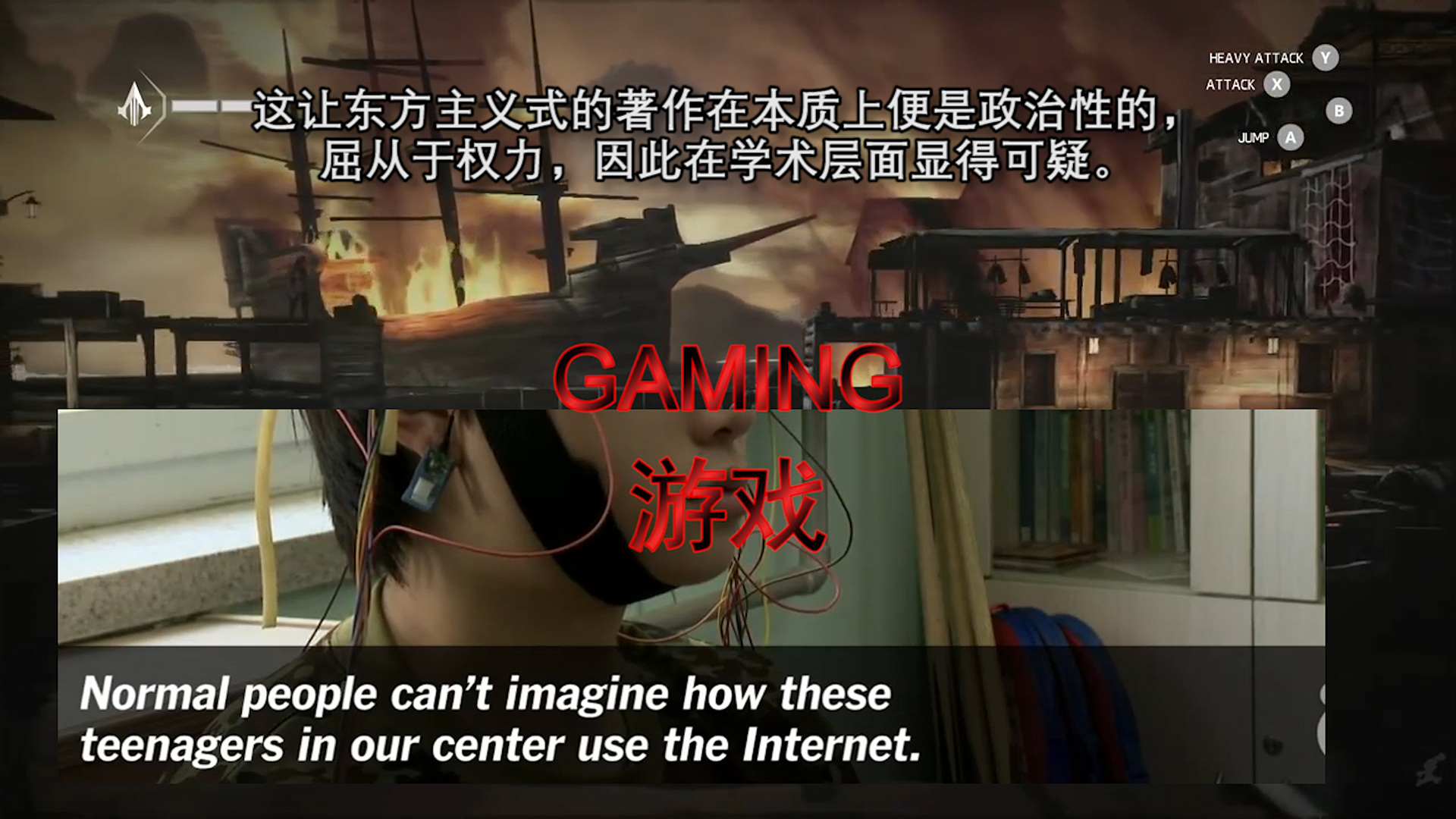
The essay is divided into seven chapters, titled after what Lek has referred to as stereotypes of “Chinese being”: Computing, Copy, Gaming, Study, Addiction, Labour, and Gambling. Lek conceives of Sinofuturism as the adoption and crystallization of these stereotypes into “a form of Artificial Intelligence,” a “massively distributed neural network.” In this way, Sinofuturism highlights similarities between the public understanding of certain features of machine learning and the Western perception of the “nameless, faceless mass of Chinese labor”—for example, “copying rather than originality” or “learning massive amounts of raw data rather than philosophical critique or morality.” The work advocates for a future in which these techno-Orientalist stereotypes are reclaimed and literalized to produce a posthuman “collective body,” an unconscious-yet-hyperintelligent network somewhere between human and machine. This vision of intelligence recalls cybernetics, the study of both biological and mechanical systems as functioning based on the same automatic processes of feedback, control, and homeostasis within a network. It is a view of life force as equilibrium, self-regulation, endless modification without disruption; ambience.
Because Lek shoots his films inside architecturally constructed virtual spaces in a game engine, these “immersive storyworld[s]” provide both the object of the camera and “the film apparatus itself” (the camera(s) is included in the game engine environment). The type of image he works with, he writes in his 2021 doctoral thesis, “exists beyond the conventional frame of visibility…it exists on an infrastructural scale, within an intertwined system of sensing and computation.” Virtual objects inside a game engine “do not merely exist merely as passive actors but can have agential characteristics.” The idea of Sinofuturistic intelligence as an unconscious, posthuman network of cybernetic relations acts as a conceptual mirror of Lek’s description of his own filmmaking: a system with the potential toward self-regulation, in which virtual objects perform complex relations with a camera in place of a conscious agent. A game that can play itself, operator on pause.
Lek’s exact ambitions with Sinofuturism as an artistic-theoretical framework are unclear. In his thesis, he resists the conflation of Sinofuturism and techno-Orientalism, but doesn’t make a very convincing effort to distinguish the two, describing only a dubious temporal difference (“Sinofuturist temporality is haunted by both past and future”). He initially describes the video essay Sinofuturism as “deliberately ironic and non-didactic,” but then goes on to explain its decolonial political ethos in great detail, comparing it to Afrofuturism and describing it as a “liberatory politics of embracing nonhuman, electronic, collective identity.” Yet, instead of enacting a truly ‘Sinofuturist’ future, the characters in Geomancer and AIDOL seem only to reinforce the boundaries between humans and AI. For example, the AI characters are either plagued by their inability to achieve human creativity (listening to a song Geo has composed, a human remarks, “Humans can’t make music this generic”) or decide to reclaim their lack of original thought. Neither film dwells on a meaningful interrogation of the idea of ‘originality’ itself.
However, perhaps, rather than a coherent political ideology or even a narrative framework for a single work, Lek’s Sinofuturism should be taken as just one tool of many working together in service of a much wider, trans-media worldbuilding project. The focus of Lek’s thesis is an unreleased, work-in-progress film project called Death Drive, which follows a self-driving car put on trial for a crash that killed a border guard. During pre-production, Lek created a real-time camera “surveillance system” within a game engine: as the virtual self-driving car propelled itself through the streets of “SimBeijing,” various other live camera views of different areas of the virtual city would appear on its dashboard.
Geomancer and AIDOL feature strange technical quirks that appear to come from limitations of game engine animation (or perhaps from Lek’s lack of mastery over it). In the few scenes in AIDOL where humans engage in dialogue, their body movements are jerky and don’t match the rhythm of their words. A strange arm gesture will loop over and over. Sometimes, the camera will suddenly jerk to one side and back again, seemingly compromised by a mysterious glitch.
In comparison to AIDOL’s many fleeting technicolor rooms, distracted camera, and literal music video sequences (see “Track 8: Superstar Lyric Video”), the trailer for Theta (what appears to be a short film version of Death Drive) shows a far more visually constrained world, appearing to consist only of highways and passing landscapes. Lek’s integrated surveillance camera mechanism also serves to make the cameras’ position completely legible. At once narrating the conditions of a Sinofuturist dystopia and simulating these conditions of control within the cinematic apparatus itself, Death Drive seems to have more effectively married Lek’s conceptual and methodological worldbuilding practices than Geomancer or AIDOL, both of which often feel simultaneously over-thought and aimless. Indeed, Lek’s “Sinofuturist cinematic universe,” it seems, is in a constant state of reformulation and expansion: in a recent Instagram post, Lek wrote that Theta and Death Drive are part of “a new series of works” and that the former is his last project made using Unreal Engine.
The aimlessness of his previous films, though, is also precisely what allows the agency of the medium itself—the game engine as a system of its own—to insert itself into the foreground. There is an inherent contradiction in a movie—made for a viewer—that depicts a world clearly designed for a player. In Geomancer and AIDOL, the blips that result from this disconnect between concept and realization point to the materiality of the game engine as a filmmaking medium. What we see in these moments is, to quote Galloway, “pure process.” It is the liminality of a medium in progress, but a medium with unprecedented capabilities for the visual realization of new structures and the role of individual figures within them. Perhaps most of all, Lek’s films remind us, by consciously depriving us of authority, of the co-constitutive role our tools play in the building of anything.
In the last scene of Geomancer, the camera follows Geo and a group of drones through the ceiling of a glass skyscraper. On the roof sits the first and only humanoid character in the film, a transparent human figure sitting on a lawn chair. It wears a VR headset and faces a view of an open ocean. In my near-hypnotized state, I wonder, is that supposed to be me? When the camera cuts to the image playing inside the headset, we see almost the exact same view: drones flying, water rippling. Even sitting inside the virtual environment, this figure is at a distance, removed by one mediating level: watching.
Or maybe…playing? Galloway writes, “there is always a kind of ‘charged expectation’ in the ambience act. It is about possibility, a subtle solicitation for the operator to return.”
Then, the voiceover chimes in: “Shui! Shui! Shui! You never render the same river twice.”
This mantra, shui, “water” in Mandarin, reminds me of the ever-changing stasis of the idle video game screen and Lek’s hypnotic screensavers; the endless, looping activity of the cybernetic machine. So does the final sentence, which references a sentiment from Heraclitus’ philosophy of universal flux: No man ever steps into the same river twice. Popular re-interpretations of the original quote extrapolate: …for it is not the same river and it is not the same man.
You never render the same river twice. Lek here offers us a meta-reflection on his process of 3D animation. Let’s sit idly for a moment and watch the eternal interplay between the tool—its ability to generate its own forms, patterns, variations, ad infinitum—and the operator-artist, shaping (and being shaped by) this ever-flowing process toward imaginations of another world.
